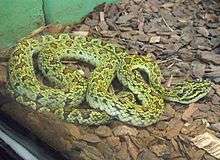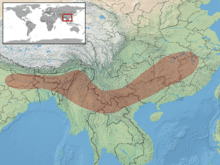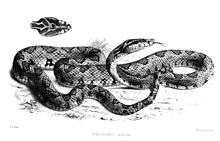Protobothrops jerdonii
Protobothrops jerdonii (Jerdon's pitviper,[2][4] yellow-speckled pit viper, oriental pit viper) is a venomous pit viper species found in India, Nepal, Myanmar, China, and Vietnam. Three subspecies are currently recognized, including the nominate subspecies described here.[2][5]
.jpg)
| Protobothrops jerdonii | |
|---|---|
 | |
| at the San Diego Zoo | |
| Scientific classification | |
| Kingdom: | Animalia |
| Phylum: | Chordata |
| Class: | Reptilia |
| Order: | Squamata |
| Suborder: | Serpentes |
| Family: | Viperidae |
| Genus: | Protobothrops |
| Species: | P. jerdonii |
| Binomial name | |
| Protobothrops jerdonii (Günther, 1875) | |
 | |
| Synonyms[2] | |
| |
Etymology
The specific name, jerdonii, is in honor of British herpetologist Thomas C. Jerdon, who collected the type series.[6]
The subspecific name, bourreti, is in honour of French herpetologist René Léon Bourret.[6]
Description
Males of P. jerdonii grow to a maximum total length of 835 mm (32.9 in), which includes a tail length of 140 mm (5.5 in); females grow to 990 mm (39 in), with a tail length of 160 mm (6.3 in).[7]
Scalation: dorsal scales in 21 longitudinal rows at midbody (rarely 23); snout length a little more than twice diameter of eye; head above, except for large internasals and supraoculars, covered by small, unequal, smooth scales that are feebly imbricate or juxtaposed; first labial completely separated from nasal scales by a suture; internasals separated by 1–2 small scales; 6–9 small scales in line between supraoculars; 7–8 upper labials, third and fourth beneath eye, in contact with subocular or separated by at most a single series of small scales; ventrals: males 164–188, females 167–193; subcaudals: males 50–78, females 44–76.[7]
Geographic range
P. jerdonii is found in northeastern India, Nepal, through northern Burma to southwestern China and Vietnam.[2] The type locality given by Günther is "Khassya" (=Khasi Hills, India).[3]
Subspecies
| Subspecies[2][5] | Taxon author[2][5] | Common name[8] | Geographic range[8] |
|---|---|---|---|
| P. j. bourreti | Klemmer, 1963 | Bourret's pitviper | Northwestern Vietnam (in the provinces of Lào Cai and Lai Châu, and possibly also in adjacent China (Yunnan). |
| P. j. jerdonii | Günther, 1875 | Jerdon's pitviper | Southwestern China (in the provinces of southern Xizang (Tibet), western Sichuan and Yunnan), northeastern India, Bangladesh, Burma (Chin and Kachin state), and northeastern Nepal. |
| P. j. xanthomelas | Günther, 1889 | red spotted pitviper | Central and southern China (in the provinces of Henan, Shaanxi, Gansu, Sichuan, Guizhou, Hubei and Guangxi) and northeastern India(Arunachal Pradesh).[9] |
References
- Wogan G, Das I, Jiang J, Bain R (2012). "Protobothrops jerdonii ". The IUCN Red List of Threatened Species 2017-2. http://oldredlist.iucnredlist.org/details/178419/0
- Protobothrops jerdonii at the Reptarium.cz Reptile Database. Accessed 30 October 2018.
- McDiarmid RW, Campbell JA, Touré T (1999). Snake Species of the World: A Taxonomic and Geographic Reference, Volume 1. Washington, District of Columbia: Herpetologists' League. 511 pp. ISBN 1-893777-00-6 (series). ISBN 1-893777-01-4 (volume).
- Brown JH (1973). Toxicology and Pharmacology of Venoms from Poisonous Snakes. Springfield, Illinois: Charles C. Thomas. 184 pp. LCCCN 73–229. ISBN 0-398-02808-7.
- "Trimeresurus jerdonii". Integrated Taxonomic Information System. Retrieved 25 May 2007.
- Beolens, Bo; Watkins, Michael; Grayson, Michael (2011). The Eponym Dictionary of Reptiles. Baltimore: Johns Hopkins University Press. xiii + 296 pp. ISBN 978-1-4214-0135-5. (Protobothrops jerdonii, p. 134; P. j. bourreti, p. 35).
- Leviton, A.E.; Wogan, G.O.U.; Koo, M.S.; Zug, G.R.; Lucas, R.S. & Vindum, J.V. (2003). "The dangerously venomous snakes of Myanmar. Illustrated checklist with keys" (PDF). Proceedings of the California Academy of Sciences. 54 (24): 407–462.
- Gumprecht A, Tillack F, Orlov NL, Captain A, Ryabov S (2004). Asian Pitvipers. First Edition. Berlin: GeitjeBooks. 368 pp. ISBN 3-937975-00-4.
- Zambre, Amod; Sheth, Chintan; Dalvi, Shashank; Kulkarni, Nirmal (2009). "First record of Protobothrops jerdonii xanthomelas (Günther, 1889) from Eaglenest Wildlife Sanctuary, India". J. Bombay Nat. Hist. Soc. 106 (2): 325-327.
Further reading
- Boulenger GA (1890). The Fauna of British India, Including Ceylon and Burma. Reptilia and Batrachia. London: Secretary of State for India in Council. (Taylor and Francis, Printers). xviii + 541 pp. (Trimeresurus jerdonii, pp. 427–428).
- Boulenger GA (1896). Catalogue of the Snakes in the British Museum (Natural History). Volume III., Containing the ... Viperidæ. London: Trustees of the British Museum (Natural History). (Taylor and Francis, printers). xiv + 727 pp. + Plates I-XXV. (Lachesis jerdonii, pp. 551–552).
- Das I (2002). A Photographic Guide to Snakes and other Reptiles of India. Sanibel Island, Florida: Ralph Curtis Books. 144 pp. ISBN 0-88359-056-5. (Protobothrops jerdonii, p. 63).
- Günther A (1875). "Second Report on Collections of Indian Reptiles obtained by the British Museum". Proc. Zool. Soc. London 1875: 224–234. (Trimeresurus jerdonii, new species, pp. 233–234 + Plate XXXIV).
- Smith MA (1943). The Fauna of British India, Ceylon and Burma, Including the Whole of the Indo-Chinese Sub-region. Reptilia and Amphibia. Vol. III.—Serpentes. London: Secretary of State for India. (Taylor and Francis, printers). xii + 583 pp. (Trimeresurus jerdoni, pp. 510–511, Figure 162).
External links
| Wikimedia Commons has media related to Protobothrops jerdonii. |

